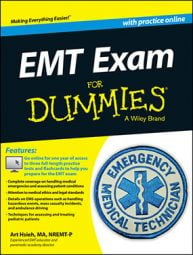You should always use practice exams before arriving to take the EMT exam. Practice exams are a great tool for helping you prepare for the big day. Preparation and study can go a long way.
Sample questions
Directions: Choose the best answer to each question. Mark the corresponding oval on the answer sheet.
Your patient presents with a rash on both hands after being exposed to poison oak. She has an allergy to peanuts and has her epinephrine autoinjector. You should
(A)administer oxygen.
(B)administer her epinephrine autoinjector.
(C)have the patient self-administer diphenhydramine (Benadryl).
(D)listen to her lung sounds.
A 22-year-old male is unconscious after being stung by a bee. He has a weak radial pulse, and his skin is cool, pale, and diaphoretic. You auscultate wheezes in both lung fields. Which of the following would most likely correct the underlying problem?
(A)Administration of the patient’s prescribed metered-dose inhaler
(B)Ventilation with a bag-valve-mask device
(C)Oxygen administration
(D)Administration of the patient’s prescribed epinephrine autoinjector
The most effective way of preventing the spread of infectious disease is to
(A)use sterile techniques when possible.
(B)wash your hands.
(C)require immunizations for all infectious disease.
(D)properly dispose of all contaminated linens.
Your patient presents with a history of fever, night sweats, and malaise. You note that he is coughing up spots of blood. You should
(A)administer oxygen.
(B)obtain a full set of vital signs.
(C)listen to his lungs.
(D)put on a HEPA mask.
Which of the following infectious diseases is transmittable by coming in contact with an infected person’s blood?
(A)Croup
(B)Hepatitis
(C)Tuberculosis
(D)Influenza
A 6-month-old male has a two-day history of low-grade fever, tachypnea, and wheezing. Auscultation of lung sounds reveals inspiratory and expiratory wheezes to all lobes bilaterally. You suspect that the patient has
(A)epiglottitis.
(B)pneumonia.
(C)croup.
(D)bronchiolitis.
Your patient is confused but is able to follow directions. His wife states that he “may have taken too much insulin.” His pulse rate is 102 per minute, and his blood pressure is 128/90 mm Hg. He is breathing 14 times per minute with noticeable chest rise and fall. Your next step is to
(A)administer oxygen via a nonrebreather mask.
(B)administer oral glucose.
(C)inquire more into his past medical history.
(D)hold cervical spine stabilization.
A 12-year-old Type 1 diabetic female is unresponsive. There is gurgling in her airway. A parent says her blood sugar level is low. You should first
(A)administer oral glucose.
(B)obtain a set of vital signs.
(C)suction her airway.
(D)insert a nasopharyngeal airway.
A 62-year-old Type 2 diabetic is in a nursing home. Staff reports that the patient has had a four-day history of declining mental status, with increased thirst and urine output over the same time period. He is most likely suffering from
(A)hypoglycemia.
(B)hyperglycemia.
(C)pneumonia.
(D)septic shock.
Which of the following occurs as blood glucose levels fall below about 70 mg/dL?
(A)Type 2 diabetes develops.
(B)Glucagon secretion increases.
(C)Insulin secretion increases.
(D)Hyperglycemia develops.
Answers and explanations
D. You want to know whether the patient is having a simple allergic reaction or whether anaphylaxis may be occurring. Evaluating her skin signs, taking her vital signs, and listening for wheezing in her lungs, Choice (D), helps you tell the difference between the two conditions.
D. Although there is wheezing, which may lead you to Choice (A), the wheezing is likely to be from the bee sting. Bag-valve-mask ventilation, Choice (B), and oxygen administration, Choice (C), are both treatments that the patient will receive, but the administration of epinephrine will correct the vasodilation and bronchospasm characteristic of anaphylaxis.
B. Hand washing is the most effective way to prevent the spread of infectious disease.
D. You will administer oxygen, Choice (A); obtain a set of vital signs, Choice (B); and listen to the patient’s lung sounds, Choice (C); but only after protecting yourself first with a HEPA mask, Choice (D).
B. Croup, tuberculosis, and influenza, Choices (A), (C), and (D), respectively, are spread primarily through the airborne route.
D. Epiglottitis, Choice (A), and croup, Choice (C), are upper airway conditions and don’t result in wheezing. Wheezing may be associated with pneumonia, Choice (B), but it’s unlikely that pneumonia would involve all lung fields in both lungs.
B. The administration of oxygen, Choice (A), and asking more questions about his medical history, Choice (C), are things that should be done, but only after administering oral glucose, Choice (B), to correct the underlying problem. Holding cervical spine stabilization, Choice (D), is unnecessary considering the information provided.
C. The administration of oral glucose, Choice (A), is contraindicated in this patient due to her decreased level of consciousness. You should obtain vital signs, Choice (B), after completion of the primary assessment. A nasopharyngeal airway, Choice (D), may be used, but only after suctioning the secretions from her airway, Choice (C).
B. Increased urination and increased thirst are not associated with hypoglycemia, Choice (A). There are no signs associated with an infection, as Choices (C) and (D) suggest, such as fever, bedsore, cough, nausea, vomiting, or diarrhea.
B. Type 2 diabetes, Choice (A), is associated with hyperglycemia, not hypoglycemia. Insulin secretion, Choice (C), decreases as blood glucose levels decrease. Hyperglycemia, Choice (D), is said to exist when blood glucose levels rise above 110–120 mg/dL.

